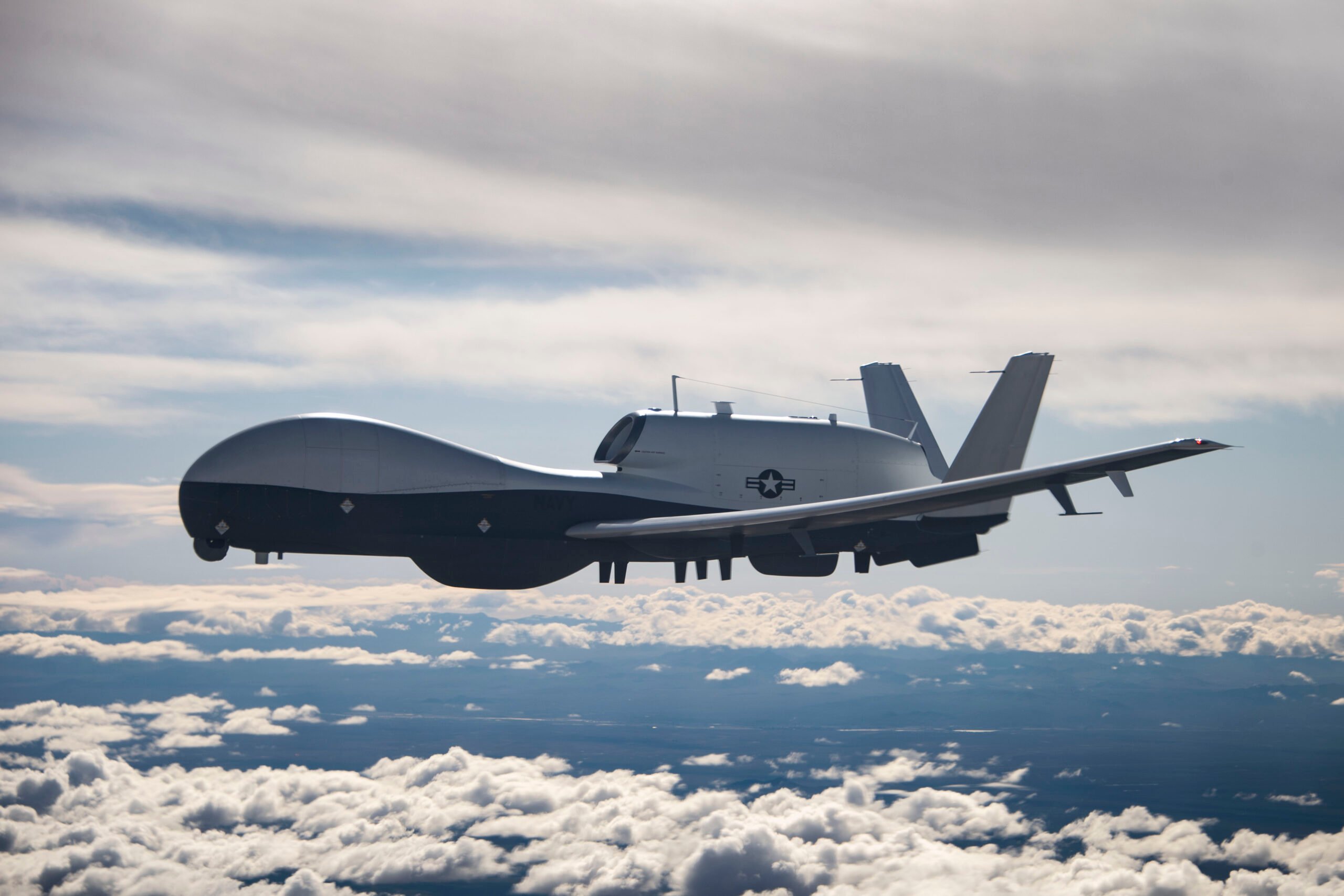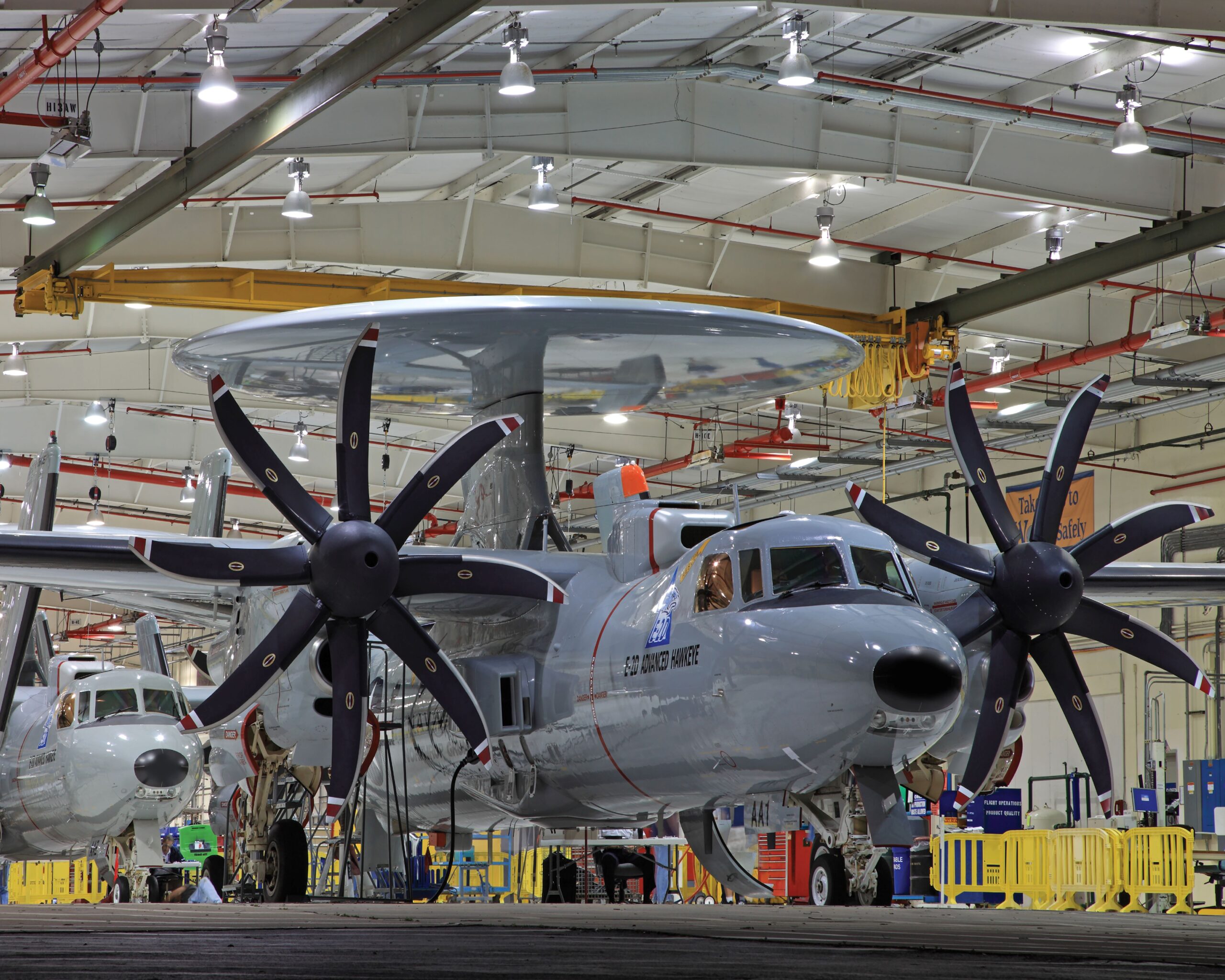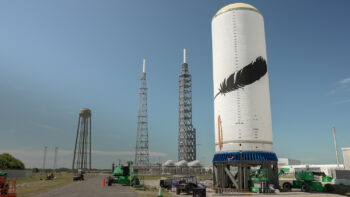
Northrop Grumman delivers the fourth MQ-4C Triton for long-range, persistent, maritime surveillance to the U.S. Navy for Initial Operational Capability. Image courtesy of Northrop Grumman.
In this Q&A with Northrop Grumman’s Nick Chaffey, Chief Executive and General Manager for UK and Mission Systems Europe, and Jane Bishop, Vice President and General Manager, Global Surveillance Division, we discuss: the defense needs and avenues for partnership across Europe, the High North, and the Indo-Pacific; some details on how airborne surveillance platforms execute in land and maritime environments; and the company’s space capabilities for Skynet and mission extension.
Breaking Defense: Where is Northrop Grumman expanding internationally, and to meet what missions?

Nick Chaffey, Chief Executive and General Manager for UK and Mission Systems Europe, Northrop Grumman.
Chaffey: We’re seeing significant increases in demand for leading edge defence capabilities as a result of the threat from Russia, given the events in Ukraine, that has led to a significant shift in defence and security strategy by many countries across Europe, as well as the US, of course. This is further amplified by the increasing threat perceived from a more assertive and more capable China.
International business is a high priority for Northrop Grumman in order to help allied customers around the world respond to those threats with leading-edge capabilities that Northrop Grumman as a defense technology company is so well known for.
We’ve had a significant business in the UK for many decades and have around 1,000 people focused on areas ranging from cybersecurity to maritime systems to aviation, along with an increasing presence in the space domain in the UK.
We also have a substantial presence in Australia with a range of businesses from aircraft sustainment and air battle management, to systems integration and cybersecurity. Here we’re responding to challenges that the UK is also seeing, namely around airborne surveillance, sensors and sensor integration, and C2.
Looking at the challenges our allies are facing, Northrop Grumman has combat proven advanced sensing capabilities, such as the MESA sensor on the E-7 platform, that support mission requirements. MESA scans the skies around the aircraft and provides critical domain awareness in the evolving battlespace to allow the operator to make informed decisions.
Looking at wider Europe, we see a plethora of demands from our allies in response to the very clear and present danger being presented by Russia. All the European nations have increased their defense spending, all are reviewing their defense strategy, and we’re seeing some quite extraordinary changes in the scale of investment and scale of response in places like Poland and Germany where we already have businesses and presence.
In Poland we’re working closely with the Polish MOD and local industry on short- and medium-range air defense. In May, Northrop Grumman delivered key components for the Integrated Battle Command System (IBCS), which is the centerpiece of the country’s modernization strategy for both their WISLA medium range-air-and-missile-defense program and their NAREW short-range air defense program. Poland is the first international partner to acquire this transformational capability.
When we look further east, we have close relations with customers in the Middle East, Japan, Taiwan, and South Korea, and we’re working with them to understand their requirements, particularly in areas of advanced weapons like: AARGM [Advanced Anti-Radiation Guided Missile] that are becoming more important; advanced sensors to understand the threat and provide better information about the battlespace; and C2 to fuse it together to drive an effective response. Then there’s next-generation air requirements including significant ISR requirements, which Jane can speak to.
Breaking Defense: What active programs does Northrop Grumman’s Global Surveillance have in Europe and elsewhere today?

Jane Bishop, Vice President and General Manager, Global Surveillance Div., Northrop Grumman.
Bishop: Nick did a great job of wrapping up the current security environment, and we’re certainly seeing an increase in interest in the European region as well as in Asia Pacific. Within my division, which includes Global Hawk, Triton, and E-2D, we are focused on delivering ISR&T [intelligence, surveillance, reconnaissance, and targeting], as well as multi-domain command-and-control capability around the globe. Our customers have a real need for actionable information at their fingertips and are all clamoring for that capability.
For the RQ-4 Global Hawk, we’ve delivered variants to NATO, as well as Korea and Japan, and those aircraft are operating around the globe today. We have our international launch customer for Triton with Australia, with first flight of that Australian aircraft later this year and then delivery of that capability to the Australians next year.
We’ve delivered E-2C Hawkeyes around the globe; Japan, France, Taiwan, and Egypt are all current operators for the E-2C. Our international launch customer for the E-2D Advanced Hawkeye was Japan, and we’re about to go under contract with France for three aircraft. Anybody familiar with the E-2C certainly understands the robust capability that platform brings in over-water conditions. From an E-2D perspective, one of the tremendous capabilities that it brings to the table is the ability to provide that degree of surveillance not just over water but over land, as well. We’ve seen results coming from E-2D operating over land and the results are very compelling. E-2D is certainly equipped to deliver very robust over-land capability equal to what can be achieved over water.
As we think ahead to the future with the current, global security environment, we’re seeing a number of opportunities present themselves. For example, we think E-2D is an off-the-shelf capability for Poland and a great solution for their AEW [airborne early warning] requirement.
We’ve been talking about how we couple IBCS together with E-2D to make a one-plus-one-is-three solution that we think would be a force multiplier for Poland. Our US Navy customer certainly stands behind that platform as the digital quarterback for their carrier strike groups.
Looking at other areas of need within Europe and the High North, Norway has expressed interest in the MQ-4C Triton. There’s no other platform in the world that can provide the long-range, persistent, maritime surveillance requirement that Triton can deliver.
My portfolio also includes Fire Scout MQ-8C, an autonomous helicopter based on a Bell 407. While we’re making good progress with our US Navy customer, we do have international aspirations for Fire Scout. It’s a very versatile platform; it can do an ISR&T mission as well as mine countermeasure missions, and even resupply; whether it’s ship-based or land-based. There are some great opportunities for that platform, as well.

The international launch customer for the E-2D Advanced Hawkeye was Japan, and Northrop Grumman is about to go under contract with France for three aircraft. Image courtesy of Northrop Grumman.
Breaking Defense: What are your thoughts on what the UK’s Skynet Enduring Capability programme wants to accomplish and how Northrop Grumman can help to define the procurement program and ultimately execute on the programme’s goals for satellite communications?
Chaffey: We see the Skynet programme as an exciting opportunity to contribute to UK defense in a market leading and technologically innovative way. We’re partnered with Airbus to combine exceptional UK industrial capability in space and cutting-edge payload production with leading US space technologies.
We’re currently bidding for the Skynet Narrowband Satellite System requirement, which will be delivered through a dedicated military communications satellite in GEO orbit. That competition has started and we’re actively working to deliver a highly competitive proposal to the MOD. Then the Skynet Wideband Satellite System competition commences in the next few months, which is a requirement for multiple space systems and their associated technologies — all areas where our space capabilities provide ideal solutions for the UK’s requirement.
We see these as great opportunities to bring leading US capabilities to play in this important and complex market, and also expand our UK and European presence in the space sector. There are multiple programs we’re currently talking to UK customers about, including satellite life extension and capability enhancement, where systems capabilities like Northrop Grumman’s Mission Extension Vehicle (MEV) and Mission Extension Pods (MEP) could be relevant to extending the life and features of the current Skynet 5 satellite fleet. This mission would enable the UK to potentially manage some of the challenges in delivering military satellite communications capability over the next decade, while also providing some quite unique capabilities on-orbit.
We also hope to announce in the next few months another strategic space program in the UK which would be a big step forward in the context of UK/US Space Domain Awareness (SDA) collaboration.
Breaking Defense: Final thoughts?
Bishop: When looking at our portfolio and Triton and E-2D, in particular, we can say something that not everybody can say. That is, we can deliver a proven, unrivaled capability and we have hot production lines. We’re prepared to deliver on the capability needed by today’s and tomorrow’s customers.
Chaffey: Northrop Grumman is investing more and is more focused strategically in the UK and European market in response to the needs of our allies. We are keen to leverage both the leading-edge capabilities we have from the US, and, importantly, also those businesses, teams, and industrial partners we have in the UK and Europe to deliver world-leading solutions that become sovereign to those nations. Northrop Grumman is one of very few that can do that and do that with a strategic commitment that you’re seeing us making.





















